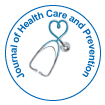Understanding and Managing Nausea during Pregnancy: Causes, Impact, and Strategies for Relief
Received: 01-Mar-2025 / Manuscript No. jhcpn-25-163701 / Editor assigned: 03-Mar-2025 / PreQC No. jhcpn-25-163701(PQ) / Reviewed: 17-Mar-2025 / QC No. jhcpn-25-163701 / Revised: 22-Mar-2024 / Manuscript No. jhcpn-25-163701(R) / Published Date: 28-Mar-2024
Abstract
Nausea during pregnancy, commonly referred to as "morning sickness," affects approximately 70-80% of expectant mothers, primarily during the first trimester, though some women experience symptoms throughout the entire pregnancy. The precise cause of nausea remains unclear, but it is believed to be linked to hormonal changes, particularly elevated levels of human chorionic gonadotropin (hCG) and estrogen, along with increased sensitivity to odors and gastrointestinal alterations. The severity of symptoms can vary, ranging from mild discomfort to more intense nausea that leads to vomiting and significant distress, affecting a woman’s quality of life. The condition is categorized into mild, moderate, and severe nausea, with hyperemesis gravid arum-affecting 1-3% of pregnant women—requiring medical intervention. Management strategies include dietary changes, hydration, rest, stress management, and medications such as vitamin B6 and doxylamine. Alternative treatments like acupuncture and acupressure may also offer relief. Support from healthcare providers, family, and friends plays a vital role in helping women cope with this condition.
Introduction
Nausea during pregnancy, commonly known as "morning sickness," affects around 70-80% of pregnant women, often beginning in the first trimester. While it may seem like a minor issue, the impact of nausea can be far-reaching, affecting physical, emotional, and social well-being. This condition can range from mild discomfort to severe nausea and vomiting, which may persist throughout the pregnancy in some cases. Understanding its causes, symptoms, and management strategies is essential for both expectant mothers and healthcare providers.
Nausea typically begins between the 6th and 8th week of pregnancy and often resolves by the end of the first trimester. However, some women experience it throughout the pregnancy. The condition can profoundly affect a woman's quality of life, requiring appropriate medical and emotional support [1-5].
Methodology
The study of nausea in pregnancy involves a comprehensive approach, combining clinical assessments, observational studies, and interventions to explore its prevalence, causes, and effective management strategies. Key components of this methodology include study design, participant selection, data collection methods, and analysis. A combination of cross-sectional and longitudinal study designs is typically used. Cross-sectional studies assess the prevalence of nausea at specific points in pregnancy, while longitudinal studies monitor its progression and effects on maternal health over time. Pregnant women are recruited from prenatal clinics, obstetric practices, and community health centers. Inclusion criteria typically include women over 18 years old with confirmed pregnancies, primarily within the first trimester. Exclusion criteria may involve women with pre-existing gastrointestinal conditions, multiple pregnancies, or those on treatments that could influence nausea. Methods of data collection include surveys, interviews, and clinical assessments. Standardized questionnaires, such as the Pregnancy Unique Quantification of Emesis (PUQE) scale, are often used to assess the severity of nausea and vomiting. Qualitative interviews provide deeper insights into the personal experiences of women, including triggers, coping strategies, and emotional impacts. Randomized controlled trials (RCTs) are conducted to assess the effectiveness of various interventions for managing nausea. These might include dietary changes, lifestyle modifications, herbal supplements (such as ginger), and pharmacological treatments (e.g., vitamin B6 and doxylamine). Control groups receive placebo treatments or standard care. Ethical approval is obtained from relevant institutional review boards (IRBs), ensuring informed consent and participant privacy. Safety monitoring is conducted during intervention trials to ensure no harm comes to participants [6-10].
Conclusion
Nausea during pregnancy, while common, can be distressing and significantly affect daily life. Understanding the causes and implementing effective management strategies can help alleviate symptoms and improve the overall experience of pregnancy. Dietary changes, hydration, rest, and emotional support are key components of managing nausea. In severe cases, particularly with hyperemesis gravidarum, medical intervention may be necessary. Pregnant women should seek medical attention if they experience persistent vomiting, dehydration, or significant weight loss. By staying informed and proactive, women can better manage the challenges of nausea during pregnancy, fostering a healthier and more positive experience during this important period of life.
Acknowledgment
None
Conflict of Interest
None
Citation: Maxi S (2025) Understanding and Managing Nausea during Pregnancy:Causes, Impact, and Strategies for Relief. J Health Care Prev, 8: 313.
Copyright: © 2025 Maxi S. This is an open-access article distributed under theterms of the Creative Commons Attribution License, which permits unrestricteduse, distribution, and reproduction in any medium, provided the original author andsource are credited.
Select your language of interest to view the total content in your interested language
Share This Article
Recommended Journals
Open Access Journals
Article Usage
- Total views: 80
- [From(publication date): 0-0 - Sep 04, 2025]
- Breakdown by view type
- HTML page views: 55
- PDF downloads: 25
